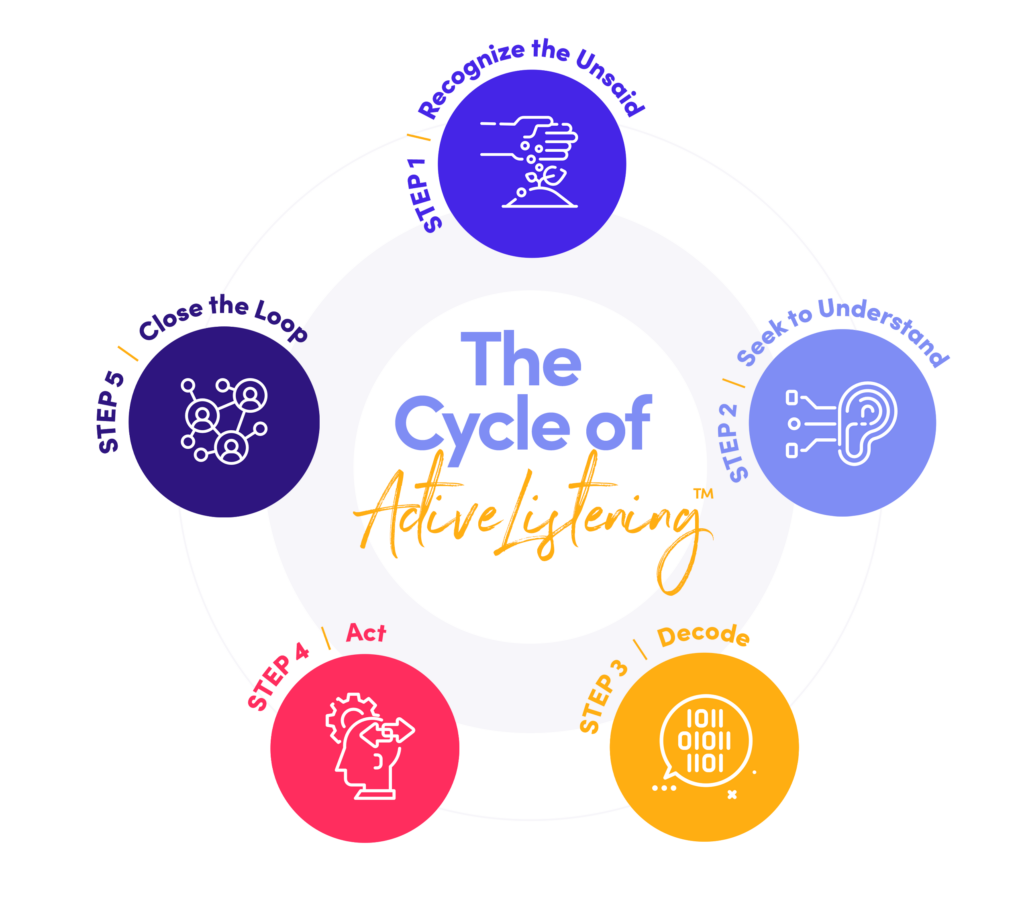
In the last four weeks, I’ve elaborated on the first four steps in the Cycle of Active Listening. Let’s recap:
- Recognizing the Unsaid – Unspoken things in your culture’s organization to recognize that your people aren’t telling their entire truth.
- Seeking to Understand – Leaning in to understand someone’s perspective and really hearing them.
- Decode – Taking time to reflect, investigate, and then ponder about the feedback you have been given and what to do about it.
- Take Action – Acting upon what you’ve heard, so your people know their voices are powerful and that you will do something about the feedback that is given.
When someone gives you feedback and goes through the first four steps above, the connecting piece to this cycle is Closing the Loop. Sometimes, many leaders, even myself, fall down on this step as it takes intentional effort. Closing the loop means that you’ve acted on the feedback you have been given and then acknowledged what you plan to do or are already actively doing about it. For example, if feedback was received in the form of a survey and not through a one-on-one meeting or a specific employee, address your team and let them know that you’ve heard them, you’ve investigated, and here’s what you’re going to do about it. Finally, presenting the end result and thanking them for their feedback.
Doing this expresses to those within your organization that they’re important. That you not only respect them as a human and more than just an employee but also be respectful of their time and their voice by letting them be heard. Providing that important validation for them to feel that their feedback meant something to you and will continue to mean something within leadership.
Feeling Heard, Understood, and Valued
So now that I’ve taken you through all five steps, think about and ask yourself how well you truly listen to others.
“How well do my skills compare in these certain areas?”
“How do I make my people feel heard, understood, and valued?”
It all starts with having the mindset to be an inclusive leader. You have the power to set the tone of comfort and culture in your organization by implementing the steps above. First, openly ask your team for feedback and ideas on a regular basis, so they know their voice and opinions are important to you. Have an open-door policy and let them know that you’re available for them to speak on anything from sharing ideas to personal hardships. Finally, ask them how you can be helpful to them. Some individuals may need to feel heard in different ways, including being made visible.
Your team might already feel comfortable with you but don’t feel heard by others – e.g., colleagues outside their department or senior leaders. If you can share presentation opportunities with your team or even just call out people’s specific contributions to others, that goes a long way in promoting their visibility, which may provide an opening for your team members to develop new relationships. Encourage your people to join employee resource groups (aka, affinity groups) and other cross-functional activities, if your company has them, to meet a variety of people.
The Cycle of Active Listening
Even as leaders, we want to be seen and heard. It comes with human nature. So imagine how that feeling can be overwhelmingly powerful to the success and retention of your employees. By building an environment upon active listening as not only a practice in Caring Leadership, but a daily skill – your continual efforts will blossom into long-term benefits. That is what closing the loop is really all about.
It ultimately falls to caring leaders to establish inclusive workplaces where everyone feels heard and prioritized. The cycle of active listening should be seen as one tool in the caring leader’s diverse arsenal of strategies. The most effective leaders realize they can better inspire their teams by being open and sharing the floor rather than dominating it.
Leadership is a journey created by improvement and growth. It’s never too late to be a caring leader by showing up for your people, meeting them where they’re at, and begin practicing the Cycle of Active Listening. Always remember, even a journey of a thousand miles must begin with one single step.